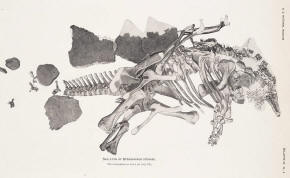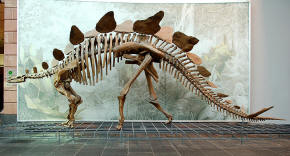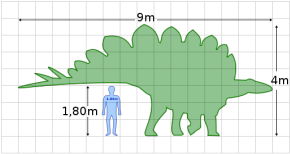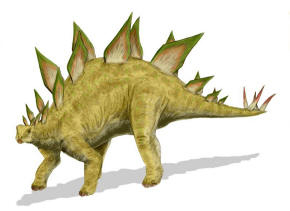|
A large, heavily built, herbivorous
quadruped,
Stegosaurus had a
distinctive and unusual posture, with a heavily rounded back, short
forelimbs, head held low to the ground and a stiffened tail held high in the
air. Its array of plates and spikes has been the subject of much
speculation. The spikes were most likely used for defense, while the plates
have also been proposed as a defensive mechanism, as well as having display
and thermoregulatory (heat
control) functions.
Stegosaurus
was the largest of all the stegosaurians (bigger
than genera such as
Kentrosaurus and
Huayangosaurus) and,
although roughly bus-sized, it nonetheless shared many anatomical features
(including the tail spines and plates) with the other stegosaurian genera.
Description
Averaging around 9 meters (30 ft) long and 4 meters
(14 ft) tall, the quadrupedal Stegosaurus
is one of the most easily identifiable dinosaurs, due to the distinctive
double row of kite-shaped plates rising vertically along its rounded back
and the two pairs of long spikes extending horizontally near the end of its
tail. Although a large animal, it was dwarfed by its contemporaries, the
giant sauropods. Some form of
armor appears to have
been necessary, as it coexisted with large predatory theropod dinosaurs,
such as the fearsome
Allosaurus and
Ceratosaurus.
The hind feet each had three short
toes, while each forefoot had five toes; only the inner two toes had a blunt
hoof. All four limbs were supported by pads behind the toes. The forelimbs
were much shorter than the stocky hindlimbs, which resulted in an unusual
posture. The tail appears to have been held well clear of the ground, while
the head of Stegosaurus
was positioned relatively low down, probably no higher than 1 meter (3.3 ft)
above the ground.
The long and narrow skull was small in
proportion to the body. It had a small antorbital
 |
fenestra,
the hole between the nose and eye common to most
archosaurs, including
modern birds, though lost in extant crocodylians. The skull's low position
suggests that Stegosaurus
may have been a browser of low-growing vegetation. This interpretation is
supported by the absence of front teeth and their replacement by a horny
beak or
rhamphotheca.
Stegosaurian teeth were small, triangular and flat; wear facets show that
they did grind their food. The inset placement in the jaws suggests that
Stegosaurus had
cheeks to keep food in their mouths while they chewed.
Despite the animal's overall size,
the braincase of Stegosaurus
was small, being no larger than that of a dog. A well-preserved
Stegosaurus braincase
allowed
Othniel Charles Marsh
to obtain in the 1880s a cast of the brain cavity or endocast of the animal,
which gave an indication of the brain size. The endocast showed that the
brain was indeed very small, maybe the smallest among the dinosaurs. The
fact that an animal weighing over 4.5 metric tons (5 short tons) could have
a brain of no more than 80 grams (2.8 oz) contributed to the
popular old idea that dinosaurs were unintelligent, an idea now largely
rejected.
Most of the information known about
Stegosaurus comes
from the remains of mature animals; however more recently juvenile remains
of Stegosaurus have
been found. One sub-adult specimen, discovered in 1994 in Wyoming, is 4.6
meters (15 ft) long and 2 meters (7 ft) high, and is estimated to have
weighed 2.3 metric tons (2.6 short tons) while alive. It is on display in
the University of Wyoming Geological Museum. Even smaller skeletons, 210
centimeters (6.9 ft) long and 80 centimeters (2.6 ft) tall at the back, are
on display at the Denver Museum of Nature & Science.
Origins
The origin of
Stegosaurus is uncertain,
as few remains of basal stegosaurs and their ancestors are known. Recently,
stegosaurids have been shown to be present in the lower Morrison Formation,
existing several million years before the occurrence of
Stegosaurus itself, with
the discovery of the related
Hesperosaurus from the
early
Kimmeridgian. The
earliest stegosaurid (the genus
Lexovisaurus) is known
from the
Oxford Clay Formation
of England and France, giving it an age of early to middle
Callovian.
The earlier and more basal genus
Huayangosaurus from
the Middle Jurassic of China (some 165 million years ago) predates
Stegosaurus by 20 million
years and is the only genus in the family Huayangosauridae. Earlier still is
Scelidosaurus, from
Early Jurassic England, which lived approximately 190 million years ago.
Interestingly, it possessed features of both stegosaurs and ankylosaurs.
Emausaurus from
Germany was another small quadruped, while
Scutellosaurus from
Arizona in the USA was
an even earlier genus and was facultatively bipedal. These small, lightly
armored dinosaurs were closely related to the direct ancestor of both
stegosaurs and ankylosaurs. A trackway of a possible early armored dinosaur,
from around 195 million years ago, has been found in France.
Discovery
and species
Stegosaurus,
one of the many dinosaurs first collected and described in the
Bone Wars,
 |
| Articulated holotype of S. stenops (USNM 4934), known as
the "road kill" specimen |
was
originally named by Othniel Charles Marsh
in 1877, from remains recovered north of Morrison, Colorado.
These first bones became the
holotype of
Stegosaurus armatus. Marsh
initially believed the remains were from an aquatic turtle-like animal, and
the basis for its
scientific name,
'roof(ed) lizard' was due to his early belief that the plates lay flat over
the animal's back, overlapping like the
shingles (tiles)
on a roof. A wealth of Stegosaurus
material was recovered over the next few years and Marsh published several
papers on the genus. Initially, several species were described. However,
many of these have since been considered to be invalid or synonymous with
existing species, leaving two well-known and one poorly known species.
Confirmed Stegosaurus
remains have been found in the Morrison Formation's stratigraphic zones 2–6,
with additional remains possibly referrable to
Stegosaurus recovered from stratigraphic zone 1.Valid
species
 | Stegosaurus armatus,
meaning "armored roof lizard", was the first species to be found and is
known from two partial skeletons, two partial skulls and at least thirty
fragmentary individuals. This species had four horizontal tail spikes
and relatively small plates. At 9 meters (30 ft), it was the longest
species within the genus Stegosaurus. |
 | Stegosaurus longispinus,
meaning "long-spined roof lizard", was named by
Charles W. Gilmore
and known from one partial skeleton, from the
Morrison Formation
in
Wyoming.
Stegosaurus longispinus
was notable for its set of four unusually long tail spines. Some
consider it a species of
Kentrosaurus. Like
S. stenops, it
grew to 7 meters (23 ft) in length. |
 | Stegosaurus stenops,
meaning "narrow-faced roof lizard", was named by Marsh in 1887, with the
holotype having
been collected by Marshal Felch at Garden Park, north of Cañon City, Colorado, in 1886.
This is the best-known species of
Stegosaurus, mainly because its remains
include at least one complete articulated skeleton. It had large, broad
plates and four tail spikes. Stegosaurus
stenops is known from at least 50 partial
skeletons of adults and juveniles, one complete skull and four partial
skulls. It was shorter than S. armatus,
at 7 meters (23 ft). |
Return to the
Old Earth Ministries Online Dinosaur
Curriculum homepage.

Shopping
Bay
State Replicas - Skull, Dorsal Vertebra, Dorsal Fin Plate, Fin Plate &
Tail Spike
Black
Hills Institute - Complete Skeleton, Skull
|




